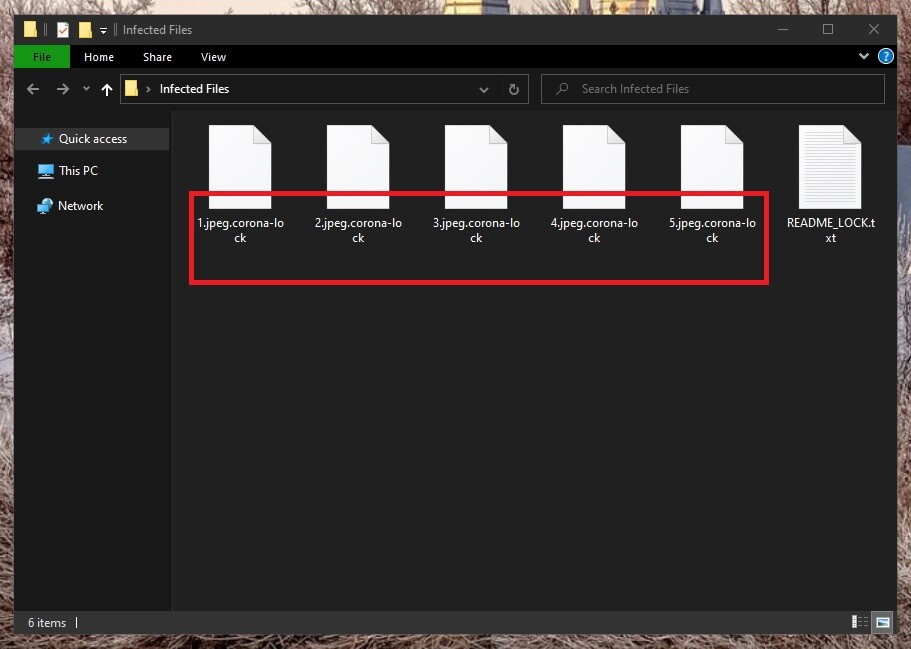Corona-lock
Corona-lock is a ransomware cryptovirus that is used for online blackmail purposes and money extortion. Corona-lock uses advanced cryptography to restrict access to certain files and demands a ransom payment to send the victims a decryption key.

In general, Ransomware is incredibly common extortion software that can cause the loss of a lot of valuable digital files. Such infections seek to encrypt their victims’ files and make them unavailable, so that hackers can subsequently blackmail users to pay ransoms to decrypt them. The strategy is very clear. The crooks promise that the victim will receive a unique decryption key to reverse the complex code applied to their files as soon as they pay the required money. At least this is what you’re told by the hackers in a message which will be displayed on your screen by the virus the moment all your files have been successfully encrypted.
Of course, if the encrypted files are not especially important for you, you should ignore the ransom-requesting message and simply remove the ransomware from your computer. The good news is that, aside from blocking access to stored information, ransomware-based viruses normally don’t cause any permanent system damage that will prevent you from using your computer as before. That’s why, as long as you successfully remove Corona-lock , you can start using your computer right away and safely connect any file-backup sources that you may have.
However, if Corona-lock has already encrypted files that are of great importance to you but you don’t have backups of them, you may have to face a very unpleasant dilemma that must be treated with care. Basically, you have to choose between either agreeing to pay the hackers behind the ransomware a ransom or looking for alternative methods for file recovery to minimize the attack’s effects.
The Corona-lock virus
The Corona-lock virus is a malicious piece of software of the ransomware type that encrypts user files with advanced encryption algorithms. After applying its encryption, the Corona-lock virus asks for a ransom payment from its victims in order to provide them with a decryption key for their information.
Many people get panicked when they face the scary ransom message that Corona-lock displays on their screen and are quick to agree to the ransom payment out of fear. However, security experts suggest that the victims or ransomware should take some time to learn about alternate ways to deal with this infection instead of immediately sending the demanded money to the hackers. This is mainly because there is absolutely no assurance that once they pay, the crooks will provide them with the mysterious decryption key. In fact, it is much more likely for them to disappear with the money. That’s why it is best to leave this choice as your very last resort and firstly explore some other methods to potentially restore your files and remove the ransomware virus.
The Corona-lock file encryption
The Corona-lock file encryption is a process by which hackers can limit access to user data using a sophisticated encryption algorithm. The Corona-lock file encryption process does not destroy the targeted data but makes it unavailable without the application of a decryption key.
The tips in our removal guide below, however, are published to help you get some of the encrypted information back without having a decryption key. To give them a try, however, don’t forget to first remove Corona-lock , as everything you manage to restore while the malware is on your computer may get encrypted again.
SUMMARY:
Remove Corona-lock Ransomware
You are dealing with a ransomware infection that can restore itself unless you remove its core files. We are sending you to another page with a removal guide that gets regularly updated. It covers in-depth instructions on how to:
1. Locate and scan malicious processes in your task manager.
2. Identify in your Control panel any programs installed with the malware, and how to remove them. Search Marquis is a high-profile hijacker that gets installed with a lot of malware.
3. How to decrypt and recover your encrypted files (if it is currently possible).
You can find the removal guide here.

Leave a Reply